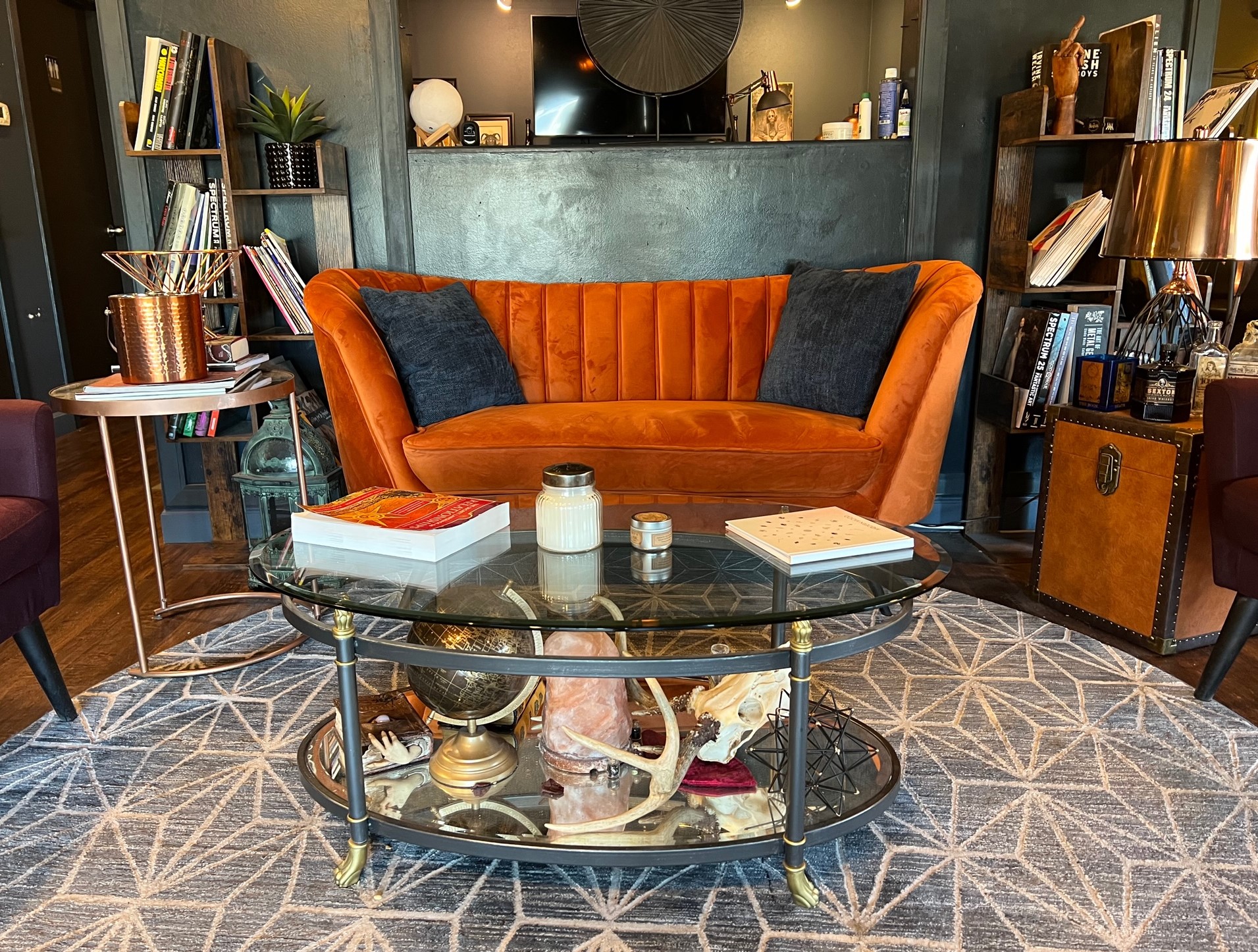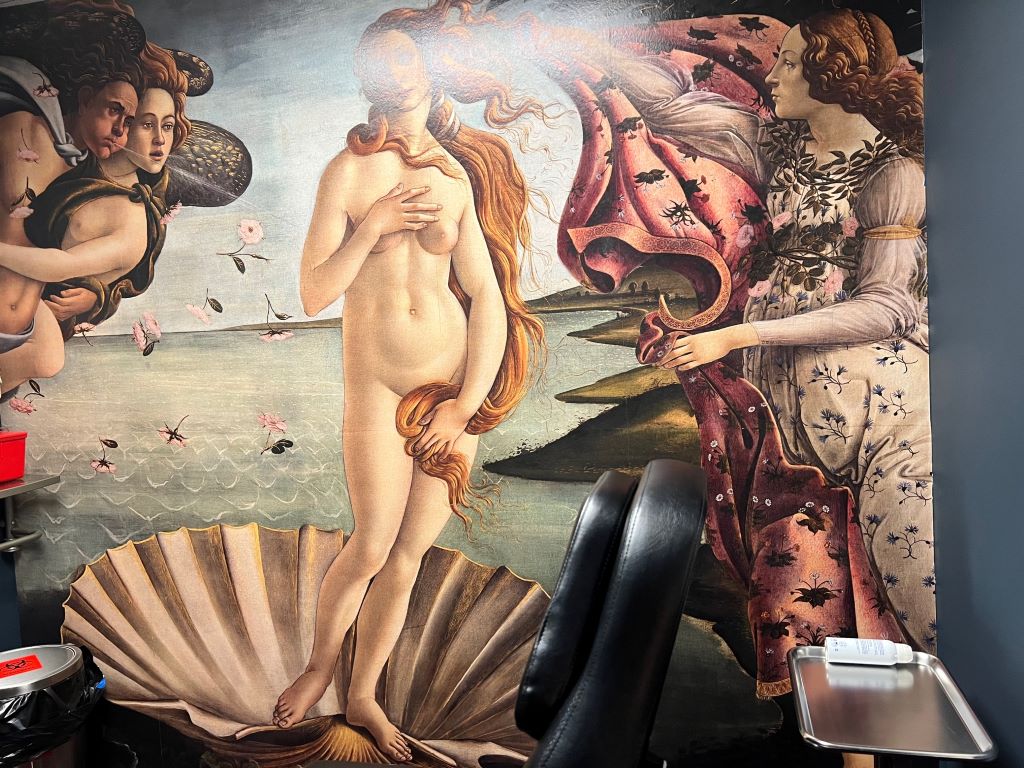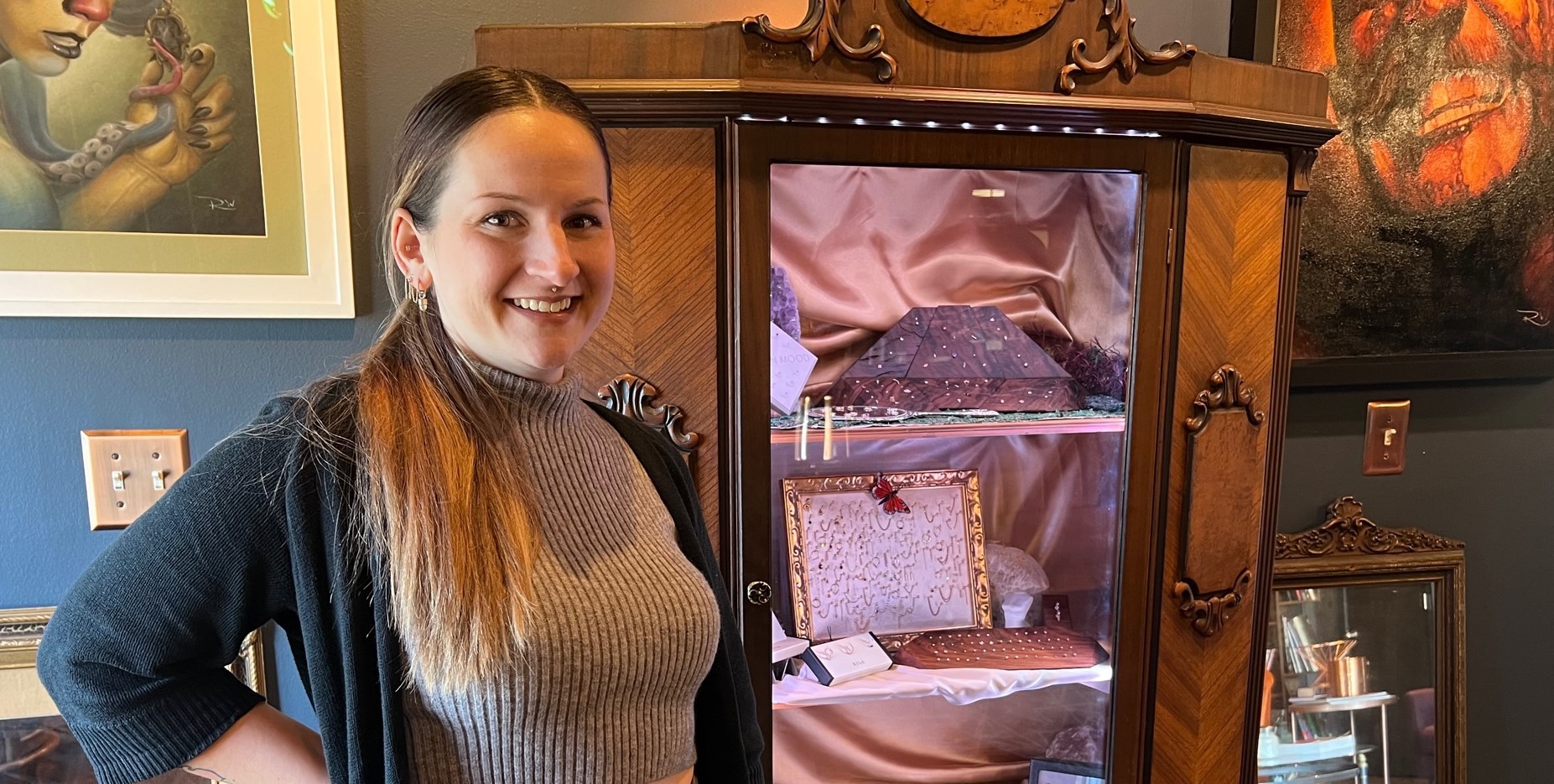You’ll find On Point Body Piercings tucked into Moonlight Studios Tattoo, which is tucked into a row of businesses at the corner of Springfield and Duncan in Champaign. It’s an instantly inviting environment, with midnight blue walls and eclectic décor. Piercing artist Christine Eshleman exudes this inviting vibe as well. She’s warm and welcoming, with the sort of demeanor you would want in someone who is about to put a needle through your chosen body part.

I first met Eshleman when I brought my teenage daughter to her for an ear piercing (then brought her back for two subsequent piercings). Last week she was kind enough to sit down with me and share a bit about her journey as a piercing artist.
Smile Politely: Can you share a little about your background?
Christine Eshleman: I grew up in Onarga, and I originally moved here to study fine arts at Parkland. I was going to be an art teacher. I was able to get an associate’s degree, but life happened and I just never continued down that road. I worked in the service industry in town for a long time. My friend Sam, who’s been my very good friend since grade school — we were peas in a pod — she’s always kind of been my “bad influence” friend. [note: Sam is one of the owners and tattoo artists at Moonlight Studios].
SP: We all have one right?
Eshleman: She was always the one that was like “Let’s go meet up with the boys” or “let’s go dye our hair.”
SP: She was the bold friend.
Eshleman: Yes exactly. But when we were younger, I feel like we could have made better choices [laughing]. She was working at No Regrets downtown, and she was given the piercing position, but she really wanted to tattoo. She wasn’t able to make any forward strides, because she was sort of held in this other position. She said “hey, I have an idea. I think you should learn how to pierce, so I can move on to tattooing.” I had a roommate that was a nurse at the time, and she would chase me around the apartment showing me pictures from her nursing book and I would be like “ugh, no!”
SP: So piercing was not on your radar?
Eshleman: No. I’ve always been squeamish, and I guess empathetic. I just don’t like to see people being hurt. [Sam] has always kind of known me better than I know myself. She would say you know, you’re going to be in control. It’s not like you’re in an emergency room. And I’m sort of a control freak.
SP: I think that’s a good quality in someone who is going to go into piercing.
Eshleman: Needless to say, she talked me into it. It was such a different environment. It was a unique place to be, and it was a different type of interaction with people. I was used to interacting with people, but this was more personal. I really took to that.
SP: What sort of steps did you have to take to learn, train, and be able to do this as a profession?
Eshleman: What’s really interesting about this industry, and the tattoo industry, is we don’t actually get a license to practice. You can get a business license, and you can have people that work under your business license, but there is no piercing license. We do have to have blood borne pathogen training. But when you compare it to the beauty industry…they have to have a certain amount of hours, they have to have a test at the end of those hours…we don’t have anything like that. Every piercer is going to have a different journey. I got an apprenticeship, and about two months later I was piercing.
SP: And you weren’t too sure about that?
Eshleman: There were a lot of things that I hadn’t seen, and it was like well if someone comes in [and asks for a service] you’re a piercer so you do it. It was really scary. The idea of possibly hurting someone, that really bothered me. I found this group, the Association of Professional Piercers, and they actually set a lot of standards in our industry. They offer continuing education, and they have a conference that gathers people from all over the world because there’s just not anything available anywhere else. I went to my first conference in 2018. After that it was like okay, now I feel like I can make these strides. I’m an astrology person, so I attribute this to being a Capricorn, but if there’s a ladder to climb, I want to climb it. If there’s something better, I want to do that. If there’s something more than I can learn, I want to learn it.
SP: I think if you’re really passionate about something, you’re motivated to want to do that.
Eshleman: It was incredible how much more there was to learn, when I thought my mentor knew everything, and that she taught me everything…and she probably did, as far as she knew. I think the thing that stuck with me the most [from the conference] was a women’s roundtable, where one of the women talked about how our work is really an energy transfer.
SP: Oh that’s interesting.
Eshleman: Because you are opening up someone’s physical body, and putting something in there. There are so many different reasons why someone gets a piercing. Sometimes it’s for control, sometimes it’s for fun.
SP: That’s something I was curious about. What sort of reasons have you seen for people wanting piercings?
Eshleman: So many things. I think a lot of it is just having control over your body, the way that you look, and being able to express yourself. For some people it’s taking back control from all different kinds of personal situations, whether it was physical or mental. You’ve probably heard that a woman will go through a break up and cut her hair. Here it’s nipple piercings. I’ll get someone who comes in for that service saying “my boyfriend never wanted me to have these and I’ve always wanted it.”
SP: It’s taking back ownership of their body in some ways.
Eshleman: Absolutely. You think about humanity’s history as a whole. We’ve been doing this forever: body modification, wearing jewelry, putting it in our bodies. A lot of times it’s a rite of passage, and very sacred. It’s cool to not just look at [piercing] at the surface level, but to look at it as meaningful work. In the beginning it was like “oh this is so much fun! This is so much better than bartending!” But now I appreciate it on a much deeper level, and I’ve gone through the steps to make sure that I feel very confident in what I’m doing, because for a long time I didn’t. I want to shed light on this. Not everyone is a good practitioner, there’s no license, not everywhere is a safe place to go.
SP: Do you have suggestions for questions people should ask? Or things they should look for in a studio?
Eshleman: One thing you can ask about is the quality of the jewelry. Surgical steel is something that’s really commonly used, but the way that I understand it is that surgical steel would be like a surgeon’s tool. They are safe enough to be used on the body, but if they were to take an organ and staple you shut, that staple that stays in your body for life is an implant grade titanium. That is a good metal to use. If it’s gold, it should be 14K solid gold, and that is considered implant grade as well. Another red flag is if they have externally threaded jewelry, versus internally threaded jewelry. If a studio is cutting corners with what they are leaving in your body, then they could be cutting corners in other places too.

SP: Is it generally better to seek out a piercing studio, rather than going to a store in the mall?
Eshleman: I have a service background, so I make sure that when people come in that it’s really an experience. There are a lot of studios that do that as well, but there are a lot of studios that don’t. You do still have to be picky.
SP: It’s not automatically going to be better.
Eshleman: It’s not. But I believe if you’re going to a good studio, you’re going to have a good experience. It’s not so casual, you’re going to be taken care of, and you’re going to feel like your body is valued. I’m here for you if there’s a problem. Things happen — it’s the human body — no matter how perfectly I’ve done it. You want to have somebody that you trust to help you navigate that. There’s a little bit of a relationship and trust. Those things matter when you’re making a permanent change.
SP: I initially found you because you are someone who will do a piercing for younger people. Is there a certain age that is the “right” age to seek out an ear piercing?
Eshleman: It can be a little bit of a hot topic. A lot of people want to pierce their baby’s ears so they don’t remember the pain. In my perspective, it’s hard to hold down a child for something like that.
SP: It seems like it ventures into the area of consent, or inability to give consent.
Eshleman: That is the argument, is that you want them to be able to consent. When I first started, we were doing them as young as three months old and it was traumatizing for me. I really did not like being the bad guy. Practically speaking, if they are really little and squishy, you can get it done and it’s not terrible. But after about six months, when they’re aware and able to grab, that’s when it starts to not feel good. When they are a little older, like two or three…let me tell you. I have a three year old, and I can’t get her to brush her teeth consistently without a fight, and that’s not painful. When you get a piercing it’s a lingering soreness for some time, and kids don’t want you to touch that, and it needs to be cleaned every day. I start at the age of seven. Since it’s only me, I can only do one ear at a time, and you have to have some skills to convince them to do it again.

SP: I imagine you have a certain way of doing things when there’s a child in your chair.
Eshleman: I try to mirror the energy of the child. Sometimes they’re on cloud nine and so excited, and other times they won’t even look at me. When you’re little you think “yeah I’d like to wear earrings” but when you come into the environment, you feel the reality of it. It’s a big shift in feelings, and they are very big feelings. Once we get back in the room, I make sure to tell them ”I’m going to let you know what’s happening as it goes on, and I want you to know that at any point and you’re not so sure, you can totally say no. If you don’t want to do it, I don’t want to do it.” One time I had a child that went through picking out the jewelry, I got her back there, and once she was in the chair she was adamant [about not going through with it]. When she left, I made sure to tell her it’s just as brave to say no to something, and that she should be proud of herself. She listened to her own voice.
SP: That probably empowers them to come back when they are ready, knowing that they have that control.
Eshleman: It’s a rite of passage, no matter which way it goes. They are learning about themselves.
SP: What was your first body piercing?
Eshleman: Sam called me one time and was like “hey, I need to practice on somebody”. I let her do my belly button. It was kind of cool because I was in my early 20’s, and I was having a hard time feeling the prettiest, and the best about my looks. I came from a small town and now I was in this “big city”. I felt cool and empowered by it. I got more out of it than a piece of jewelry.
SP: Is there anything else you want to make sure people know?
Eshleman: One thing I learned the hard way, is I went to a couple of places that really made me feel stupid to ask questions, like how dare I interrupt.
SP: I feel like for some people, it’s already out of their comfort zone to step into a tattoo or piercing studio.
Eshleman: It can be very intimidating, and I think a lot of people don’t understand that there is bedside manner. You should be the focus, and you should be the person in control. If you have a question, it should be answered with compassion and grace. It’s so important for me, and the artists that are here to create an appointment based studio. I know I have time for this person, and I can answer their questions, and take my time, and not make them feel rushed. You shouldn’t walk into a place and feel unwelcome or stupid. If that’s how they are treating you, don’t let them touch you. So many think that’s the norm, and it shouldn’t be, and it doesn’t have to be.
You can reach Christine Eshleman, including to book appointments, through Facebook or Instagram.








